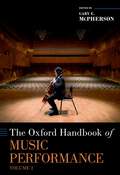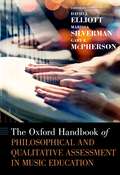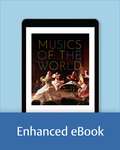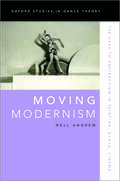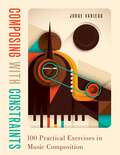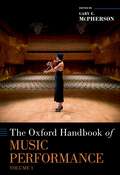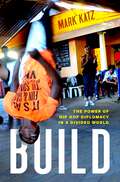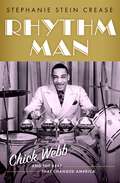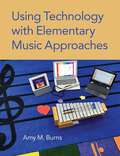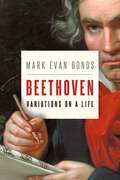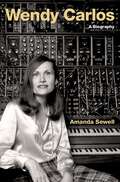- Table View
- List View
Georges Bizet's Carmen (The Oxford Keynotes Series)
by Nelly FurmanThe popularity of Carmen endures across generations and continents, with one of the most frequently performed and instantly recognizable operatic scores of all time and a libretto derived from Prosper Mérimée's novella of the same name, written 30 years prior to the opera's 1875 debut. In Georges Bizet's Carmen--the latest volume in the Oxford Keynotes series--author Nelly Furman explores the evolution of Carmen's story and its meaning, illuminating how the titular heroine has maintained her status as a universally recognizable cultural icon. Grounded in Ludovic Halévy's and Henri Meilhac's libretto--and drawing on a wealth of mostly French critical theory--this book traces the textual, operatic, and cinematic tellings and retellings of the story, from its success as a novella in the industrial age through to its iconic position in our own cinematic era. As Furman delicately navigates the fraught terrain of racial and gendered discourse and ideology that Bizet's setting of Mérimée's work traverses, she uncovers the elements of the story that give it cultural salience and resonance, both in its own right and in support of Bizet's acclaimed musical score. In doing so, Furman reveals how past and present renderings of the Carmen tale mirror the changing concerns and shifting values of individual authors and their societies--and how each new rendering has helped to embed Carmen into the global conscience.
Georges Bizet's Carmen (The Oxford Keynotes Series)
by Nelly FurmanThe popularity of Carmen endures across generations and continents, with one of the most frequently performed and instantly recognizable operatic scores of all time and a libretto derived from Prosper Mérimée's novella of the same name, written 30 years prior to the opera's 1875 debut. In Georges Bizet's Carmen--the latest volume in the Oxford Keynotes series--author Nelly Furman explores the evolution of Carmen's story and its meaning, illuminating how the titular heroine has maintained her status as a universally recognizable cultural icon. Grounded in Ludovic Halévy's and Henri Meilhac's libretto--and drawing on a wealth of mostly French critical theory--this book traces the textual, operatic, and cinematic tellings and retellings of the story, from its success as a novella in the industrial age through to its iconic position in our own cinematic era. As Furman delicately navigates the fraught terrain of racial and gendered discourse and ideology that Bizet's setting of Mérimée's work traverses, she uncovers the elements of the story that give it cultural salience and resonance, both in its own right and in support of Bizet's acclaimed musical score. In doing so, Furman reveals how past and present renderings of the Carmen tale mirror the changing concerns and shifting values of individual authors and their societies--and how each new rendering has helped to embed Carmen into the global conscience.
The Oxford Handbook of Music Performance, Volume 2 (Oxford Handbooks)
by Gary E. McphersonThe two-volume Oxford Handbook of Music Performance provides a resource that musicians, scholars and educators will use as the most important and authoritative overview of work within the areas of music psychology and performance science. The 80 experts from 13 countries who prepared the 53 chapters in this handbook are leaders in the fields of music psychology, performance science, musicology, psychology, education and music education. Chapters in the Handbook provide a broad coverage of the area with considerable expansion of the topics that are normally covered in a resource of this type. Designed around eight distinct sections - Development and Learning, Proficiencies, Performance Practices, Psychology, Enhancements, Health & Wellbeing, Science, and Innovations - the range and scope of The Oxford Handbook of Music Performance is much wider than other publications through the inclusion of chapters from related disciplines such as performance science (e.g., optimizing performance, mental techniques, talent development in non-music areas), and education (e.g., human development, motivation, learning and teaching styles) as well as the attention given to emerging critical issues in the field (e.g., wellbeing, technology, gender, diversity, inclusion, identity, resilience and buoyancy, diseases, and physical and mental disabilities). Within each chapter, authors have selected what they consider to be the most important scientific and artistic material relevant to their topic. They begin their chapters by surveying theoretical views on each topic and then, in the final part of the chapter, highlight practical implications of the literature that performers will be able to apply within their daily musical lives.
The Oxford Handbook of Music Performance, Volume 2 (Oxford Handbooks)
The two-volume Oxford Handbook of Music Performance provides a resource that musicians, scholars and educators will use as the most important and authoritative overview of work within the areas of music psychology and performance science. The 80 experts from 13 countries who prepared the 53 chapters in this handbook are leaders in the fields of music psychology, performance science, musicology, psychology, education and music education. Chapters in the Handbook provide a broad coverage of the area with considerable expansion of the topics that are normally covered in a resource of this type. Designed around eight distinct sections - Development and Learning, Proficiencies, Performance Practices, Psychology, Enhancements, Health & Wellbeing, Science, and Innovations - the range and scope of The Oxford Handbook of Music Performance is much wider than other publications through the inclusion of chapters from related disciplines such as performance science (e.g., optimizing performance, mental techniques, talent development in non-music areas), and education (e.g., human development, motivation, learning and teaching styles) as well as the attention given to emerging critical issues in the field (e.g., wellbeing, technology, gender, diversity, inclusion, identity, resilience and buoyancy, diseases, and physical and mental disabilities). Within each chapter, authors have selected what they consider to be the most important scientific and artistic material relevant to their topic. They begin their chapters by surveying theoretical views on each topic and then, in the final part of the chapter, highlight practical implications of the literature that performers will be able to apply within their daily musical lives.
The Oxford Handbook of Philosophical and Qualitative Assessment in Music Education (Oxford Handbooks)
by Marissa Silverman David J. Elliott Gary E. McPhersonThe Oxford Handbook of Philosophical and Qualitative Assessment in Music Education offers global, comprehensive, and critical perspectives on a wide range of conceptual and practical issues in music education assessment, evaluation, and feedback as these apply to various forms of music education within schools and communities. The central aims of this Handbook focus on broadening and deepening readers' understandings of and critical thinking about the problems, opportunities, spaces and places, concepts, and practical strategies that music educators and community music facilitators employ, develop, and deploy to improve various aspects of music teaching and learning around the world.
Musics of the World
by Sean WilliamsMusics of the World offers a rich and inviting introduction to music from around the globe, exploring a diverse array of traditions and genres in depth while helping students develop skills for approaching new music in their lives. Clear, accessible introductory chapters give students a solid overview of ethnomusicology, setting the stage for eighteen geographically-focused chapters that ground students in a region's cultural context before exploring what makes each place musically unique. Throughout, videos, timed musical tracks, definitions, color photographs, recipes, and discussion questions provide a variety of avenues through which to engage with the music and cultures at hand.
Moving Modernism: The Urge to Abstraction in Painting, Dance, Cinema (Oxford Studies in Dance Theory)
by Nell AndrewThe emergence of modern dance and the early history of cinema ran concurrent with the European avant-garde's development of pictorial abstraction in the first decades of the 20th century. However, many assume that modernist abstraction resulted from a century of natural, autonomous evolution to painting styles and tastes. In Moving Modernism, author Nell Andrew challenges this assumption. By examining dance and film created during this period, she argues that performative modes of art created the link between bodily movement and movement depicted in modernist paintings. In a seeming paradox, dance and film - durational arts, involving real bodies in space-participated in the development of abstract art. With archival material collected in North America and Europe, Moving Modernism resurfaces lost performances, identifies working methods, and establishes the circles of aesthetic influence and reception for avant-garde dance pioneers and experimental film makers from the turn of the century to the interwar period. Reexamining the motivation that fueled the emergence of abstraction, Andrew claims that painters sought meaning not only in the material and formal picture but also in temporal and sensorial experience. Andrew looks at major figures and intellectual movements including Loïe Fuller and Symbolism; Valentine de Saint-Point and the Cubo-Futurist and neo-Symbolist movements; and early cinematic abstraction from Edison and the Lumières to Hans Richter and Marcel Duchamp. Close examinations of each figure show that theatrical display, embodied self-projection, and kinesthetic desire are not necessarily in opposition to pictorial abstraction; in fact, they expand our understanding of the urges that created modern art.
Moving Modernism: The Urge to Abstraction in Painting, Dance, Cinema (Oxford Studies in Dance Theory)
by Nell AndrewThe emergence of modern dance and the early history of cinema ran concurrent with the European avant-garde's development of pictorial abstraction in the first decades of the 20th century. However, many assume that modernist abstraction resulted from a century of natural, autonomous evolution to painting styles and tastes. In Moving Modernism, author Nell Andrew challenges this assumption. By examining dance and film created during this period, she argues that performative modes of art created the link between bodily movement and movement depicted in modernist paintings. In a seeming paradox, dance and film - durational arts, involving real bodies in space-participated in the development of abstract art. With archival material collected in North America and Europe, Moving Modernism resurfaces lost performances, identifies working methods, and establishes the circles of aesthetic influence and reception for avant-garde dance pioneers and experimental film makers from the turn of the century to the interwar period. Reexamining the motivation that fueled the emergence of abstraction, Andrew claims that painters sought meaning not only in the material and formal picture but also in temporal and sensorial experience. Andrew looks at major figures and intellectual movements including Loïe Fuller and Symbolism; Valentine de Saint-Point and the Cubo-Futurist and neo-Symbolist movements; and early cinematic abstraction from Edison and the Lumières to Hans Richter and Marcel Duchamp. Close examinations of each figure show that theatrical display, embodied self-projection, and kinesthetic desire are not necessarily in opposition to pictorial abstraction; in fact, they expand our understanding of the urges that created modern art.
Composing with Constraints: 100 Practical Exercises in Music Composition
by Jorge VariegoComposing with Constraints: 100 Practical Exercises in Music Composition provides an innovative approach to the instruction of the craft of music composition based on tailored exercises to help students develop their creativity. When composition is condensed to a series of logical steps, it can then be taught and learned more efficiently. With this approach in mind, Jorge Variego offers a variety of practical exercises to help student composers and instructors to create tangible work plans with high expectations and successful outcomes. Each chapter starts with a brief note on terminology and general recommendations for the instructor. The first five chapters offer a variety of exercises that range from analysis and style imitation to the use of probabilities. The chapter about pre-compositional approaches offers original techniques that a student composer can implement in order to start a new work. Based on lateral thinking, the last section of the book fosters creative connections with other disciplines such as math, visual arts, and architectural acoustics. The one hundred exercises contain a unique set of guidelines and constraints that place students in a specific compositional framework. These compositional boundaries encourage students to produce creative work within a given structure. Using the methodologies in this book, students will be able to create their own outlines for their compositions, making intelligent and educated compositional choices that balance reasoning with intuition.
Composing with Constraints: 100 Practical Exercises in Music Composition
by Jorge VariegoComposing with Constraints: 100 Practical Exercises in Music Composition provides an innovative approach to the instruction of the craft of music composition based on tailored exercises to help students develop their creativity. When composition is condensed to a series of logical steps, it can then be taught and learned more efficiently. With this approach in mind, Jorge Variego offers a variety of practical exercises to help student composers and instructors to create tangible work plans with high expectations and successful outcomes. Each chapter starts with a brief note on terminology and general recommendations for the instructor. The first five chapters offer a variety of exercises that range from analysis and style imitation to the use of probabilities. The chapter about pre-compositional approaches offers original techniques that a student composer can implement in order to start a new work. Based on lateral thinking, the last section of the book fosters creative connections with other disciplines such as math, visual arts, and architectural acoustics. The one hundred exercises contain a unique set of guidelines and constraints that place students in a specific compositional framework. These compositional boundaries encourage students to produce creative work within a given structure. Using the methodologies in this book, students will be able to create their own outlines for their compositions, making intelligent and educated compositional choices that balance reasoning with intuition.
The Oxford Handbook of Music Performance, Volume 1 (Oxford Handbooks)
by Gary E. McphersonThe two-volume Oxford Handbook of Music Performance provides a resource that musicians, scholars and educators will use as the most important and authoritative overview of work within the areas of music psychology and performance science. The 80 experts from 13 countries who prepared the 53 chapters in this handbook are leaders in the fields of music psychology, performance science, musicology, psychology, education and music education. Chapters in the Handbook provide a broad coverage of the area with considerable expansion of the topics that are normally covered in a resource of this type. Designed around eight distinct sections - Development and Learning, Proficiencies, Performance Practices, Psychology, Enhancements, Health & Wellbeing, Science, and Innovations - the range and scope of The Oxford Handbook of Music Performance is much wider than other publications through the inclusion of chapters from related disciplines such as performance science (e.g., optimizing performance, mental techniques, talent development in non-music areas), and education (e.g., human development, motivation, learning and teaching styles) as well as the attention given to emerging critical issues in the field (e.g., wellbeing, technology, gender, diversity, inclusion, identity, resilience and buoyancy, diseases, and physical and mental disabilities). Within each chapter, authors have selected what they consider to be the most important scientific and artistic material relevant to their topic. They begin their chapters by surveying theoretical views on each topic and then, in the final part of the chapter, highlight practical implications of the literature that performers will be able to apply within their daily musical lives.
The Oxford Handbook of Music Performance, Volume 1 (Oxford Handbooks)
The two-volume Oxford Handbook of Music Performance provides a resource that musicians, scholars and educators will use as the most important and authoritative overview of work within the areas of music psychology and performance science. The 80 experts from 13 countries who prepared the 53 chapters in this handbook are leaders in the fields of music psychology, performance science, musicology, psychology, education and music education. Chapters in the Handbook provide a broad coverage of the area with considerable expansion of the topics that are normally covered in a resource of this type. Designed around eight distinct sections - Development and Learning, Proficiencies, Performance Practices, Psychology, Enhancements, Health & Wellbeing, Science, and Innovations - the range and scope of The Oxford Handbook of Music Performance is much wider than other publications through the inclusion of chapters from related disciplines such as performance science (e.g., optimizing performance, mental techniques, talent development in non-music areas), and education (e.g., human development, motivation, learning and teaching styles) as well as the attention given to emerging critical issues in the field (e.g., wellbeing, technology, gender, diversity, inclusion, identity, resilience and buoyancy, diseases, and physical and mental disabilities). Within each chapter, authors have selected what they consider to be the most important scientific and artistic material relevant to their topic. They begin their chapters by surveying theoretical views on each topic and then, in the final part of the chapter, highlight practical implications of the literature that performers will be able to apply within their daily musical lives.
Fugue in the Sixteenth Century
by Paul WalkerExamining the roots of the classical fugue and the early history of non-canonic fugal writing, Paul Walker's Fugue in the Sixteenth Century explores the three principal fugal genres of the period: motet, ricercar, and canonza. The volume treats each genre in turn, tracing the fugue's development throughout the century and highlighting important moments and trends along the way. Taking a two-tiered approach, Walker, on one level, examines fugue from the perspective of contemporary musicians, and on another level, takes into account fugue's later history and the elements that came to play a significant role in its formation. Walker is the first scholar to successfully tie together the various strands of the "pre-Bach fugue" thanks to the growing availability of editions of the repertories involved. He also takes account of recent work elucidating the change in compositional approach around 1500 from a basis in cantus firmus and canon to one favoring non-canonical, fugal imitation. Featuring well-chosen musical examples to illustrate the compositional developments of the sixteenth century, Fugue in the Sixteenth Century is a definitive study for both specialist musicologists and organists and harpsichordists alike.
Fugue in the Sixteenth Century
by Paul WalkerExamining the roots of the classical fugue and the early history of non-canonic fugal writing, Paul Walker's Fugue in the Sixteenth Century explores the three principal fugal genres of the period: motet, ricercar, and canonza. The volume treats each genre in turn, tracing the fugue's development throughout the century and highlighting important moments and trends along the way. Taking a two-tiered approach, Walker, on one level, examines fugue from the perspective of contemporary musicians, and on another level, takes into account fugue's later history and the elements that came to play a significant role in its formation. Walker is the first scholar to successfully tie together the various strands of the "pre-Bach fugue" thanks to the growing availability of editions of the repertories involved. He also takes account of recent work elucidating the change in compositional approach around 1500 from a basis in cantus firmus and canon to one favoring non-canonical, fugal imitation. Featuring well-chosen musical examples to illustrate the compositional developments of the sixteenth century, Fugue in the Sixteenth Century is a definitive study for both specialist musicologists and organists and harpsichordists alike.
Build: The Power of Hip Hop Diplomacy in a Divided World
by Mark KatzSince 2001, the U.S. Department of State has been sending hip hop artists abroad to perform and teach as goodwill ambassadors. There are good reasons for this: hip hop is known and loved across the globe, acknowledged and appreciated as a product of American culture. Hip hop has from its beginning been a means of creating community through artistic collaboration, fostering what hip hop artists call building. A timely study of U.S. diplomacy, Build: The Power of Hip Hop Diplomacy in a Divided World reveals the power of art to bridge cultural divides, facilitate understanding, and express and heal trauma. Yet power is never single-edged, and the story of hip hop diplomacy is deeply fraught. Drawing from nearly 150 interviews with hip hop artists, diplomats, and others in more than 30 countries, Build explores the inescapable tensions and ambiguities in the relationship between art and the state, revealing the ethical complexities that lurk behind what might seem mere goodwill tours. Author Mark Katz makes the case that hip hop, at its best, can promote positive, productive international relations between people and nations. A U.S.-born art form that has become a voice of struggle and celebration worldwide, hip hop has the power to build global community when it is so desperately needed. Cover image: Sylvester Shonhiwa, aka Bboy Sly, Harare, Zimbabwe, February 2015. Photograph by Paul Rockower.
Build: The Power of Hip Hop Diplomacy in a Divided World
by Mark KatzSince 2001, the U.S. Department of State has been sending hip hop artists abroad to perform and teach as goodwill ambassadors. There are good reasons for this: hip hop is known and loved across the globe, acknowledged and appreciated as a product of American culture. Hip hop has from its beginning been a means of creating community through artistic collaboration, fostering what hip hop artists call building. A timely study of U.S. diplomacy, Build: The Power of Hip Hop Diplomacy in a Divided World reveals the power of art to bridge cultural divides, facilitate understanding, and express and heal trauma. Yet power is never single-edged, and the story of hip hop diplomacy is deeply fraught. Drawing from nearly 150 interviews with hip hop artists, diplomats, and others in more than 30 countries, Build explores the inescapable tensions and ambiguities in the relationship between art and the state, revealing the ethical complexities that lurk behind what might seem mere goodwill tours. Author Mark Katz makes the case that hip hop, at its best, can promote positive, productive international relations between people and nations. A U.S.-born art form that has become a voice of struggle and celebration worldwide, hip hop has the power to build global community when it is so desperately needed. Cover image: Sylvester Shonhiwa, aka Bboy Sly, Harare, Zimbabwe, February 2015. Photograph by Paul Rockower.
Rhythm Man: Chick Webb and the Beat that Changed America (CULTURAL BIOGRAPHIES SERIES)
by Stephanie Stein CreaseThe first comprehensive biography of the Swing Era's pioneering virtuoso drummer and bandleader William Henry "Chick" Webb (1905-39) was one of the first virtuoso drummers in jazz and an innovative bandleader dubbed the "Savoy King," who reigned at Harlem's world-famous Savoy Ballroom. Along with the likes of Duke Ellington, Fletcher Henderson, and Cab Calloway, Webb helped create the popular dance and music culture, known as Swing, that swept the United States during and after the Great Depression and left an indelible impact on American culture. Having moved to Harlem from Baltimore during the Harlem Renaissance, Webb's creativity, charisma and persistence enabled him to navigate the harsh realities of racism and show business, lifting not only himself to stardom but also bringing other future legends-namely vocalist extraordinaire Ella Fitzgerald and R&B trailblazer Louis Jordan-along with him. But at the peak of his fame, at just 34 years of age, his life was cut short by the chronic spinal tuberculosis that had left him four feet tall with a hump on his back. In this first comprehensive biography of Webb, author Stephanie Stein Crease traces his story in full, showing how his skills and innovations as a bandleader helped catalyze the music of the Swing Era and the growing big band industry, allowing Webb to become one of the most influential musicians in jazz history. Crease explores Webb's personal and professional struggles as he rose to the top of the increasingly competitive world of big band jazz. Complete with rare photographs, posters, news clippings, and a discography, this biography will be a gift to jazz aficionados and scholars.
Rhythm Man: Chick Webb and the Beat that Changed America (CULTURAL BIOGRAPHIES SERIES)
by Stephanie Stein CreaseThe first comprehensive biography of the Swing Era's pioneering virtuoso drummer and bandleader William Henry "Chick" Webb (1905-39) was one of the first virtuoso drummers in jazz and an innovative bandleader dubbed the "Savoy King," who reigned at Harlem's world-famous Savoy Ballroom. Along with the likes of Duke Ellington, Fletcher Henderson, and Cab Calloway, Webb helped create the popular dance and music culture, known as Swing, that swept the United States during and after the Great Depression and left an indelible impact on American culture. Having moved to Harlem from Baltimore during the Harlem Renaissance, Webb's creativity, charisma and persistence enabled him to navigate the harsh realities of racism and show business, lifting not only himself to stardom but also bringing other future legends-namely vocalist extraordinaire Ella Fitzgerald and R&B trailblazer Louis Jordan-along with him. But at the peak of his fame, at just 34 years of age, his life was cut short by the chronic spinal tuberculosis that had left him four feet tall with a hump on his back. In this first comprehensive biography of Webb, author Stephanie Stein Crease traces his story in full, showing how his skills and innovations as a bandleader helped catalyze the music of the Swing Era and the growing big band industry, allowing Webb to become one of the most influential musicians in jazz history. Crease explores Webb's personal and professional struggles as he rose to the top of the increasingly competitive world of big band jazz. Complete with rare photographs, posters, news clippings, and a discography, this biography will be a gift to jazz aficionados and scholars.
USING TECH ELEMENTARY MUSIC APPROACHES C
by Amy M. BurnsDo you find it challenging to integrate technology into your elementary music classroom? Do you feel that it could enhance your classroom experience if you could implement it in an approachable and realistic way? In Using Technology with Elementary Music Approaches, author Amy M. Burns offers an all-in-one, classroom-vetted guide to integrate technology into the music classroom while keeping with core educational strategies. In this book, you will find practical lessons and ideas that can be used in any elementary classroom, whether that classroom has one device per educator or a device for every student. Written for a range of experience levels, lessons further enhance classrooms that utilize the approaches of Feierabend, Kodály, Orff Schulwerk, and project-based learning. Experts from each field-Dr. Missy Strong, Glennis Patterson, Ardith Collins, and Cherie Herring-offer a variety of approaches and project ideas in the project-based learning section. Complemented by a companion website of lesson videos, resource guides, and more, Using Technology with Elementary Music Approaches allows new and veteran educators to hit the ground running on the first day of school.
Using Technology with Elementary Music Approaches
by Amy M. BurnsDo you find it challenging to integrate technology into your elementary music classroom? Do you feel that it could enhance your classroom experience if you could implement it in an approachable and realistic way? In Using Technology with Elementary Music Approaches, author Amy M. Burns offers an all-in-one, classroom-vetted guide to integrate technology into the music classroom while keeping with core educational strategies. In this book, you will find practical lessons and ideas that can be used in any elementary classroom, whether that classroom has one device per educator or a device for every student. Written for a range of experience levels, lessons further enhance classrooms that utilize the approaches of Feierabend, Kodály, Orff Schulwerk, and project-based learning. Experts from each field-Dr. Missy Strong, Glennis Patterson, Ardith Collins, and Cherie Herring-offer a variety of approaches and project ideas in the project-based learning section. Complemented by a companion website of lesson videos, resource guides, and more, Using Technology with Elementary Music Approaches allows new and veteran educators to hit the ground running on the first day of school.
Beethoven: The Imperative Of Originality In The Symphony (Eastman Studies In Music Ser. #172)
by Mark Evan BondsDespite the ups and downs of his personal life and professional career-even in the face of deafness-Beethoven remained remarkably consistent in his most basic convictions about his art. This inner consistency, the music historian Mark Evan Bonds argues, provides the key to understanding the composer's life and works. Beethoven approached music as he approached life, weighing whatever occupied him from a variety of perspectives: a melodic idea, a musical genre, a word or phrase, a friend, a lover, a patron, money, politics, religion. His ability to unlock so many possibilities from each helps explain the emotional breadth and richness of his output as a whole, from the heaven-storming Ninth Symphony to the eccentric Eighth, and from the arcane Great Fugue to the crowd-pleasing Wellington's Victory. Beethoven's works, Bonds argues, are a series of variations on his life. The iconic scowl so familiar from later images of the composer is but one of many attitudes he could assume and project through his music. The supposedly characteristic furrowed brow and frown, moreover, came only after his time. Discarding tired myths about the composer, Bonds proposes a new way of listening to Beethoven by hearing his music as an expression of his entire self, not just his scowling self.
Beethoven: Variations on a Life
by Mark Evan BondsDespite the ups and downs of his personal life and professional career-even in the face of deafness-Beethoven remained remarkably consistent in his most basic convictions about his art. This inner consistency, the music historian Mark Evan Bonds argues, provides the key to understanding the composer's life and works. Beethoven approached music as he approached life, weighing whatever occupied him from a variety of perspectives: a melodic idea, a musical genre, a word or phrase, a friend, a lover, a patron, money, politics, religion. His ability to unlock so many possibilities from each helps explain the emotional breadth and richness of his output as a whole, from the heaven-storming Ninth Symphony to the eccentric Eighth, and from the arcane Great Fugue to the crowd-pleasing Wellington's Victory. Beethoven's works, Bonds argues, are a series of variations on his life. The iconic scowl so familiar from later images of the composer is but one of many attitudes he could assume and project through his music. The supposedly characteristic furrowed brow and frown, moreover, came only after his time. Discarding tired myths about the composer, Bonds proposes a new way of listening to Beethoven by hearing his music as an expression of his entire self, not just his scowling self.
Wendy Carlos: A Biography (Cultural Biographies)
by Amanda SewellWith her debut album Switched-On Bach, composer and electronic musician Wendy Carlos (b. 1939) brought the sound of the Moog synthesizer to a generation of listeners, helping to effect arguably one of the most substantial changes in popular music's sound since musicians began using amplifiers. Her story is not only one of a person who blazed new trails in electronic music for decades but is also the story of a person who intersected in many ways with American popular culture, medicine, and social trends during the second half of the 20th century and well into the 21st. There is much to tell about her life and about the ways in which her life reflects many dimensions of American culture. Carlos's identity as a transgender woman has shaped many aspects of her life, her career, how she relates to the public, and how the public has received her and her music. Cultural factors surrounding the treatment of transgender people affected many of the decisions that Carlos has made over the decades. Additionally, cultural reception and perception of transgender people has colored how journalists, scholars, and fans have written about Carlos and her music for decades.
Wendy Carlos: A Biography (Cultural Biographies)
by Amanda SewellWith her debut album Switched-On Bach, composer and electronic musician Wendy Carlos (b. 1939) brought the sound of the Moog synthesizer to a generation of listeners, helping to effect arguably one of the most substantial changes in popular music's sound since musicians began using amplifiers. Her story is not only one of a person who blazed new trails in electronic music for decades but is also the story of a person who intersected in many ways with American popular culture, medicine, and social trends during the second half of the 20th century and well into the 21st. There is much to tell about her life and about the ways in which her life reflects many dimensions of American culture. Carlos's identity as a transgender woman has shaped many aspects of her life, her career, how she relates to the public, and how the public has received her and her music. Cultural factors surrounding the treatment of transgender people affected many of the decisions that Carlos has made over the decades. Additionally, cultural reception and perception of transgender people has colored how journalists, scholars, and fans have written about Carlos and her music for decades.
Schoenberg's Correspondence With Alma Mahler (Schoenberg in Words)
by Elizabeth Keathley Marilyn McCoyA fresh perspective on two well-known personalities, Schoenberg's Correspondence with Alma Mahler documents a modern music friendship beginning in fin-de-siécle Vienna and ending in 1950s Los Angeles. This volume is the first English-language edition of the complete extant correspondence in new English translations from the original German, many from new transcriptions of handwritten originals, and it is the first English-language book of Schoenberg's correspondence with a female associate. These often quite candid letters afford readers a fascinating glimpse into the personalities, ideologies, institutions, protocols, and aesthetics of early twentieth-century European music culture. Critics, conductors, composers, and visual artists are appraised, kindly or venomously; visual artists and writers also appear. Above all, Alma Mahler (1879-1964) and Arnold Schoenberg (1874-1951) emerge as intriguing, complex individuals who transcend their conventional representations as, respectively, a femme fatale and a musical radical. For Schoenberg, Alma was a sympathetic confidante, a comrade in their shared battle against musical conservatism, yet also a canny negotiator of Vienna's social circles, a skill that brought Schoenberg into contact with important patrons. Not only did he invite Alma to his premieres, lectures, and art exhibitions, but Schoenberg also sent her scores of his music and drafts of his writings. He revealed to her his plans for his innovative new music society, the Society for Private Music Performances, and his development of a new method of composition with twelve tones. The letters remind us of how crucial the social and personal dimensions of music culture were to the early twentieth-century composers and musicians. Gender, ethnicity, and social class conditioned their opportunities in music---and in life---and their shared experience of fleeing fascism to a new country with a different culture and language resonates with our own epoch.

